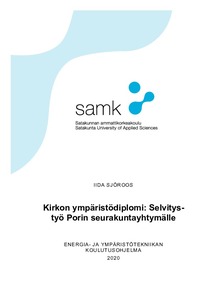Kirkon ympäristödiplomi: Selvitystyö Porin seurakuntayhtymälle
Sjöroos, Iida (2020)
Sjöroos, Iida
2020
All rights reserved. This publication is copyrighted. You may download, display and print it for Your own personal use. Commercial use is prohibited.
Julkaisun pysyvä osoite on
https://urn.fi/URN:NBN:fi:amk-2020110222090
https://urn.fi/URN:NBN:fi:amk-2020110222090
Tiivistelmä
Opinnäytetyön tavoitteena oli toteuttaa Porin seurakuntayhtymälle ympäristökartoitus, joka on Kirkon ympäristödiplomin hakuprosessin ensimmäinen vaihe. Kirkon ympäristödiplomi on evankelis-luterilaisen kirkon laatima ympäristöjärjestelmä, joka on suunniteltu seurakuntien käyttöön. Ympäristödiplomi on otettu käyttöön vuonna 2001 ja sen myöntää Kirkkohallitus.
Aluksi työssä käytiin läpi kansainväliset ympäristöjärjestelmät ISO 14001 ja EMAS, joihin Kirkon ympäristödiplomikin pohjautuu. Seuraavaksi työssä esiteltiin Kirkon ympäristödiplomi ja Porin seurakuntayhtymä. Yhtymän toimintojen ympäristövaikutukset kartoitettiin haastatteluilla ja kyselyillä. Kysymykset perustuivat ympäristödiplomin käsikirjan painokseen vuodelta 2012 ja niihin pyrittiin saamaan mahdollisimman kattavat vastaukset kaikilta seurakunnilta. Työssä on esitetty myös kehitysehdotuksia, joita yhtymässä voitaisiin lähteä työstämään.
Kartoituksessa ilmeni, että seurakuntayhtymän toiminnot täyttävät jo osan ympäristödiplomin vaatimuksista, mutta kehitettävääkin vielä löytyy. Selkeitä kokonaisuuksia, joihin olisi hyvä kiinnittää huomiota ovat esimerkiksi kiinteistöjen energiatehokkuus, hankintojen ympäristökriteerit, energian- ja vedenkulutuksen vähentäminen ja kierrätyksen tehostaminen.
Tämän selvityksen myötä seurakunnalla on edellytykset pienentää toimintojensa ympäristövaikutuksia ja jatkaa tärkeää ympäristötyötä. Seuraavana vaiheena seurakuntayhtymän tulee laatia kartoituksen pohjalta ympäristöohjelma, johon kirjataan kehityskohteet ja -tavoitteet sekä toteutusaikataulu. The aim of the thesis was to carry out an environmental review for the Pori parish unit. That is the first step of the Church's Environmental Diploma application process. The Church’s Environmental Diploma is an environmental system developed by the Evangelical Lutheran Church and it’s designed for the use of parishes. The environmental diploma was introduced in 2001 and it is granted by the Church Council.
At the beginning of the thesis, the international environmental systems ISO 14001 and EMAS were discussed. The Church's Environmental Diploma is also based on these systems. After that the Church's Environmental Diploma and the Pori parish union were introduced. All the parish unit’s functions and their environmental effects were surveyed through interviews and questionnaires. The questions were based on the 2012 edition of the Environmental Diploma Handbook. The objective was to gather information from all the parishes, so the review would be more reliable. The thesis also includes suggestions on how the parish union could take the environmental aspects better into account.
The survey revealed that the functions of the parish unit already meet the requirements of the environmental diploma well, but there is still room for improvement. Energy efficiency of buildings, environmental criteria of procurement, reduction of energy and water consumption and efficiency of recycling are some areas that should be paid attention to.
With the help of this review the parish unit can reduce the environmental impact of its functions and continue the important environmental work. The next step for the parish unit is to draw up an environmental program. The development targets and objectives and the implementation schedule will be stated in the environmental program.
Aluksi työssä käytiin läpi kansainväliset ympäristöjärjestelmät ISO 14001 ja EMAS, joihin Kirkon ympäristödiplomikin pohjautuu. Seuraavaksi työssä esiteltiin Kirkon ympäristödiplomi ja Porin seurakuntayhtymä. Yhtymän toimintojen ympäristövaikutukset kartoitettiin haastatteluilla ja kyselyillä. Kysymykset perustuivat ympäristödiplomin käsikirjan painokseen vuodelta 2012 ja niihin pyrittiin saamaan mahdollisimman kattavat vastaukset kaikilta seurakunnilta. Työssä on esitetty myös kehitysehdotuksia, joita yhtymässä voitaisiin lähteä työstämään.
Kartoituksessa ilmeni, että seurakuntayhtymän toiminnot täyttävät jo osan ympäristödiplomin vaatimuksista, mutta kehitettävääkin vielä löytyy. Selkeitä kokonaisuuksia, joihin olisi hyvä kiinnittää huomiota ovat esimerkiksi kiinteistöjen energiatehokkuus, hankintojen ympäristökriteerit, energian- ja vedenkulutuksen vähentäminen ja kierrätyksen tehostaminen.
Tämän selvityksen myötä seurakunnalla on edellytykset pienentää toimintojensa ympäristövaikutuksia ja jatkaa tärkeää ympäristötyötä. Seuraavana vaiheena seurakuntayhtymän tulee laatia kartoituksen pohjalta ympäristöohjelma, johon kirjataan kehityskohteet ja -tavoitteet sekä toteutusaikataulu.
At the beginning of the thesis, the international environmental systems ISO 14001 and EMAS were discussed. The Church's Environmental Diploma is also based on these systems. After that the Church's Environmental Diploma and the Pori parish union were introduced. All the parish unit’s functions and their environmental effects were surveyed through interviews and questionnaires. The questions were based on the 2012 edition of the Environmental Diploma Handbook. The objective was to gather information from all the parishes, so the review would be more reliable. The thesis also includes suggestions on how the parish union could take the environmental aspects better into account.
The survey revealed that the functions of the parish unit already meet the requirements of the environmental diploma well, but there is still room for improvement. Energy efficiency of buildings, environmental criteria of procurement, reduction of energy and water consumption and efficiency of recycling are some areas that should be paid attention to.
With the help of this review the parish unit can reduce the environmental impact of its functions and continue the important environmental work. The next step for the parish unit is to draw up an environmental program. The development targets and objectives and the implementation schedule will be stated in the environmental program.
